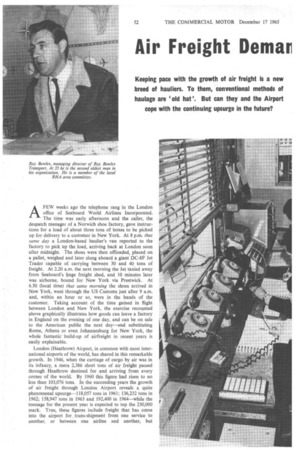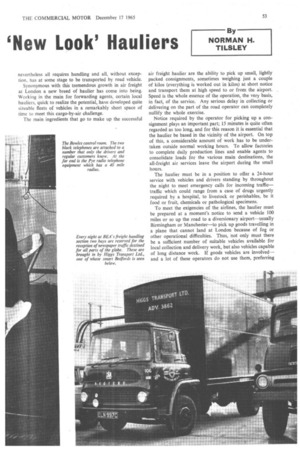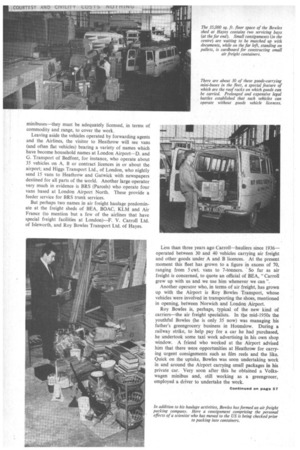Air Freight Demar 'New Look' Hauliers
Page 54

Page 55

Page 56

If you've noticed an error in this article please click here to report it so we can fix it.
AFEW weeks ago the telephone rang in the London office of Seaboard World Airlines Incorporated. The time was early afternoon and the caller, the despatch manager of a Norwich shoe factory, gave instructions for a load of about three tons of boxes to be picked up for delivery to a customer in New York. At 8 p.m. that same day a London-based haulier's van reported to the factory to pick up the load, arriving back at London soon after midnight. The shoes were then offloaded, placed on a pallet, weighed and later slung aboard a giant DC-8F Jet Trader capable of carrying between 30 and 40 tons of freight. At 2.20 a.m, the next morning the Jet taxied away from Seaboard's huge freight shed, and 10 minutes later was airborne, bound for New York via Prestwick. At 6.50 (local time) that same morning the shoes arrived in New York, went through the US Customs just after 9 a.m. and, within an hour or so, were in the hands of the customer. Taking account of the time gained in flight between London and New York, the exercise recounted above graphically illustrates how goods can leave a factory in England on the evening of one day, and can be on sale to the American public the next day—and substituting Rome, Athens or even Johannesburg for New York, the whole fantastic build-up of airfreight in recent years is easily explainable.
London (Heathrow) Airport, in common with most international airports of the world, has shared in this remarkable growth. In 1946, when the carriage of cargo by air was in its infancy, a mere 2,386 short tons of air freight passed through Heathrow destined for and arriving from every corner of the world. By 1960 this figure had risen to no less than 103,076 tons. In the succeeding years the growth of air freight through London Airport reveals a quite phenomenal upsurge-118,057 tons in 1961; 136,232 tons in 1962; 158,947 tons in 1963 and 192,400 in 1964—while the tonnage for the present year is expected to top the 230,000 mark. True, these figures include freight that has come into the airport for trans-shipment from one service to another, or between one airline and another, but nevertheless all requires handling and all, without exception, has at some stage to be transported by road vehicle.
Synonymous with this tremendous growth in air freight at London a new breed of haulier has come into being. Working in the main for forwarding agents, certain local hauliers, quick to realize the potential, have developed quite sizeable fleets of vehicles in a remarkably short space of time to meet this cargo-by-air challenge.
The main ingredients that go to make up the successful air freight haulier are the ability to pick up small, lightly packed consignments, sometimes weighing just a couple of kilos (everything is worked out in kilos) at short notice and transport them at high speed to or from the airport. Speed is the whole essence of the operation, the very basis, in fact, of the service. Any serious delay in collecting or delivering on the part of the road operator can completely nullify the whole exercise.
Notice required by the operator for picking up a consignment plays an important part; 15 minutes is quite often regarded as too long, and for this reason it is essential that the haulier be based in the vicinity of the airport. On top of this, a considerable amount of work has to be undertaken outside normal working hours. To allow factories to complete daily production lines and enable agents to consolidate loads for the various main destinations, the all-freight air services leave the airport during the small hours.
The haulier must be in a position to offer a 24-hour service with vehicles and drivers standing by throughout the night to meet emergency calls for incoming traffic— traffic which could range from a case of drugs urgently required by a hospital, to livestock or perishables, be it food or fruit, chemicals or pathological specimens.
To meet the exigencies of the airlines, the haulier must be prepared at a moment's notice to send a vehicle 100 miles or so up the road to a diversionary airport—usually Birmingham or Manchester—to pick up goods travelling in a plane that cannot land at London because of fog or other operational difficulties. Thus, not only must there be a sufficient number of suitable vehicles available for local collection and delivery work, but also vehicles capable of long distance work. If goods vehicles are involved— and a lot of these operators do not use them, preferring minibuses—they must be adequately licensed, in terms of commodity and range, to cover the work.
Leaving aside the vehicles operated by forwarding agents and the Airlines, the visitor to Heathrow will see vans (and often flat vehicles) bearing a variety of names which have become household names at London Airport D. and G. Transport of Bedfont, for instance, who operate about 35 vehicles on A, B or contract licences in or about the airport; and Higgs Transport Ltd., of London, who nightly send 15 vans to Heathrow and Gatwick with newspapers destined for all parts of the world. Another large operator very much in evidence is BRS (Parcels) who operate four vans based at London Airport North. These provide a feeder service for BRS trunk services.
But perhaps two names in air freight haulage predominate at the freight sheds of BEA, BOAC, KLM and Air France (to mention but a few of the airlines that have special freight facilities at London)—F. V. Carroll Ltd. of Isleworth, and Roy Bowles Transport Ltd. of Hayes. Less than three years ago Carroll—hauliers since 1936— operated between 30 and 40 vehicles carrying air freight and other goods under A and B licences. At the present moment this fleet has grown to a figure in excess of 70, ranging from 5 cwt. vans to 7-tonners. ' So far as air freight is concerned, to quote an official of BEA, "Carroll grew up with us and we use him whenever we can ".
Another operator who, in terms of air freight, has grown up with the Airport is Roy Bowles Transport, whose vehicles were involved in transporting the shoes, mentioned in opening, between Norwich and London Airport.
Roy Bowles is, perhaps, typical of the new kind of carriers—the air freight specialists. In the mid-1950s the youthful Bowles (he is only 35 now) was managing his father's greengrocery business in Hounslow. During a railway strike, to help pay for a car he had purchased, he undertook some taxi work advertising in his own shop window. A friend who worked at the Airport advised him that there were opportunities at Heathrow for carrying urgent consignments such as film reels and the like. Quick on the uptake, Bowles was soon undertaking work in and around the Airport carrying small packages in his private car. Very soon after this he obtained a Volkswagen minibus and, still working as a greengrocer, employed a driver to undertake the work.












































































































